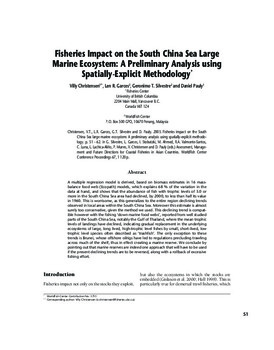Fisheries impact on the South China Sea large marine ecosystem: a preliminary analysis using spatially-explicit methodology

Citation
Christensen, V. et al. (2003). Fisheries impact on the South China Sea large marine ecosystem: a preliminary analysis using spatially-explicit methodology. Assessment, management and future directions for coastal fisheries in Asian countries. WorldFish Center conference proceedings; 67
A multiple regression model is derived, based on biomass estimates in 16 massbalance food web (Ecopath) models, which explains 68 % of the variation in the data at hand, and shows that the abundance of fish with trophic levels of 3.0 or more in the South China Sea area had declined, by 2000, to less than half its value in 1960. This is worrisome, as this generalizes to the entire region declining trends observed in local areas within the South China Sea. Moreover this estimate is almost surely too conservative, given the method we used. This declining trend is compatible however with the fishing ‘down marine food webs’, reported from well studied parts of the South China Sea, notably the Gulf of Thailand, where the mean trophic levels of landings have declined, indicating gradual replacement in the underlying ecosystems of large, long lived, high-trophic level fishes by small, short-lived, low trophic level species often described as ‘trashfish’. The only exception to these trends is Brunei, whose offshore oilrigs have led to regulations precluding trawling across much of the shelf, thus in effect creating a marine reserve. We conclude by pointing out that marine reserves are indeed one approach that will have to be used if the present declining trends are to be reversed, along with a rollback of excessive fishing effort.
Permalink
Date Available
Publisher
Countries
Copyright
CC BY 4.0
Research Themes
Language